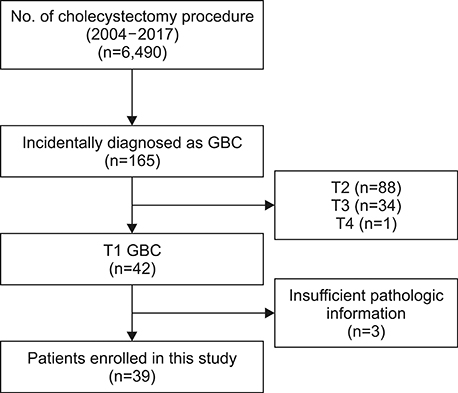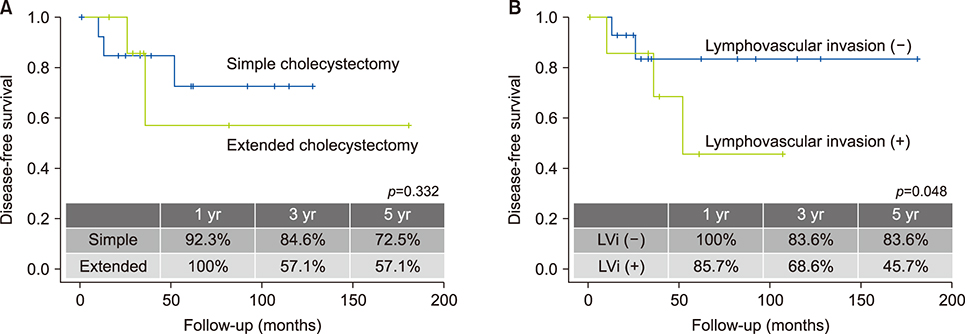Ann Hepatobiliary Pancreat Surg.
2019 Nov;23(4):327-333. 10.14701/ahbps.2019.23.4.327.
The appropriate surgical strategy for T1b gallbladder cancer incidentally diagnosed after a simple cholecystectomy
- Affiliations
-
- 1Department of Surgery, Chungnam National University Hospital, Chungnam National University School of Medicine, Daejeon, Korea. kjxh7@cnuh.co.kr
- KMID: 2464320
- DOI: http://doi.org/10.14701/ahbps.2019.23.4.327
Abstract
- BACKGROUNDS/AIMS
The appropriate surgical treatment was investigated for T1b gallbladder (GB) cancer through a retrospective analysis of the clinical outcomes of patients with incidental T1 GB cancer.
METHODS
Patients with T1 GB cancer who were incidentally diagnosed while undergoing a simple cholecystectomy at Chungnam University Hospital from January 2004 to December 2017 were enrolled. Overall, 39 patients with T1 GB cancer, 17 patients with T1a, and 22 patients with T1b were included. We retrospectively analyzed the patients' clinical and pathologic findings and follow-up results.
RESULTS
Among the 6490 patients who underwent cholecystectomy during the study period, 165 patients were diagnosed with GB cancer (T1=42 [25.5%]). The risk factor associated with recurrence and cancer-related death in patients with T1 GB cancer was lymphovascular invasion (recurrence, p=0.028; death, p=0.004). In the T1b group, the 5-year disease-free survival (DFS) rate showed a statistical difference between patients with and without lymphovascular invasion (45.7% vs. 83.6%, p=0.048). There was no statistically significant difference in 5-year DFS and overall survival rate between simple cholecystectomy and extended cholecystectomy in T1b GB cancer with lymphovasular invasion (p=0.054 and p=0.091, respectively).
CONCLUSIONS
In incidental T1b GB cancer, extended cholecystectomy was not superior to simple cholecystectomy in terms of the 5-year DFS rate and nor in overall survival rate or recurrence rate, even when lymphovascular invasion was identified after simple cholecystectomy. Therefore, simple cholecystectomy may be recommended as a primary surgical strategy for T1b GB cancer.
Keyword
MeSH Terms
Figure
Reference
-
1. Abramson MA, Pandharipande P, Ruan D, Gold JS, Whang EE. Radical resection for T1b gallbladder cancer: a decision analysis. HPB (Oxford). 2009; 11:656–663.2. Jemal A, Siegel R, Ward E, Murray T, Xu J, Smigal C, et al. Cancer statistics, 2006. CA Cancer J Clin. 2006; 56:106–130.3. Reid KM, Ramos-De la Medina A, Donohue JH. Diagnosis and surgical management of gallbladder cancer: a review. J Gastrointest Surg. 2007; 11:671–681.4. Benson AB 3rd, D'Angelica MI, Abbott DE, Abrams TA, Alberts SR, Saenz DA, et al. NCCN guidelines insights: hepatobiliary cancers, version 1.2017. J Natl Compr Canc Netw. 2017; 15:563–573.5. Eckel F, Brunner T, Jelic S. ESMO Guidelines Working Group. Biliary cancer: ESMO Clinical Practice Guidelines for diagnosis, treatment and follow-up. Ann Oncol. 2010; 21 Suppl 5:v65–v69.6. Kondo S, Takada T, Miyazaki M, Miyakawa S, Tsukada K, Nagino M, et al. Japanese Association of Biliary Surgery, Japanese Society of Hepato-Biliary-Pancreatic Surgery, Japan Society of Clinical Oncology. Guidelines for the management of biliary tract and ampullary carcinomas: surgical treatment. J Hepatobiliary Pancreat Surg. 2008; 15:41–54.7. Kim EK, Lee SK, Kim WW. Does laparoscopic surgery have a role in the treatment of gallbladder cancer? J Hepatobiliary Pancreat Surg. 2002; 9:559–563.8. Lee SE, Jang JY, Lim CS, Kang MJ, Kim SW. Systematic review on the surgical treatment for T1 gallbladder cancer. World J Gastroenterol. 2011; 17:174–180.9. Shirai Y, Yoshida K, Tsukada K, Muto T, Watanabe H. Early carcinoma of the gallbladder. Eur J Surg. 1992; 158:545–548.10. Yildirim E, Celen O, Gulben K, Berberoglu U. The surgical management of incidental gallbladder carcinoma. Eur J Surg Oncol. 2005; 31:45–52.11. Rathanaswamy S, Misra S, Kumar V, Chintamani , Pogal J, Agarwal A, et al. Incidentally detected gallbladder cancer- the controversies and algorithmic approach to management. Indian J Surg. 2012; 74:248–254.12. Toyonaga T, Chijiiwa K, Nakano K, Noshiro H, Yamaguchi K, Sada M, et al. Completion radical surgery after cholecystectomy for accidentally undiagnosed gallbladder carcinoma. World J Surg. 2003; 27:266–271.13. Butte JM, Matsuo K, Gönen M, D'Angelica MI, Waugh E, Allen PJ, et al. Gallbladder cancer: differences in presentation, surgical treatment, and survival in patients treated at centers in three countries. J Am Coll Surg. 2011; 212:50–61.14. Shih SP, Schulick RD, Cameron JL, Lillemoe KD, Pitt HA, Choti MA, et al. Gallbladder cancer: the role of laparoscopy and radical resection. Ann Surg. 2007; 245:893–901.15. Chun YS, Pawlik TM, Vauthey JN. 8th edition of the AJCC cancer staging manual: pancreas and hepatobiliary cancers. Ann Surg Oncol. 2018; 25:845–847.16. Edge SB, Compton CC. The American Joint Committee on Cancer: the 7th edition of the AJCC cancer staging manual and the future of TNM. Ann Surg Oncol. 2010; 17:1471–1474.17. Kwon AH, Imamura A, Kitade H, Kamiyama Y. Unsuspected gallbladder cancer diagnosed during or after laparoscopic cholecystectomy. J Surg Oncol. 2008; 97:241–245.18. Romano F, Franciosi C, Caprotti R, De Fina S, Porta G, Visintini G, et al. Laparoscopic cholecystectomy and unsuspected gallbladder cancer. Eur J Surg Oncol. 2001; 27:225–228.19. Zhang WJ, Xu GF, Zou XP, Wang WB, Yu JC, Wu GZ, et al. Incidental gallbladder carcinoma diagnosed during or after laparoscopic cholecystectomy. World J Surg. 2009; 33:2651–2656.20. Lee SE, Jang JY, Kim SW, Han HS, Kim HJ, Yun SS, et al. Korean Pancreas Surgery Club. Surgical strategy for T1 gallbladder cancer: a nationwide multicenter survey in South Korea. Ann Surg Oncol. 2014; 21:3654–3660.21. Lee SE, Kim KS, Kim WB, Kim IG, Nah YW, Ryu DH, et al. Korean Association of Hepato-Biliary and Pancreas Surgery. Practical guidelines for the surgical treatment of gallbladder cancer. J Korean Med Sci. 2014; 29:1333–1340.22. Downing SR, Cadogan KA, Ortega G, Oyetunji TA, Siram SM, Chang DC, et al. Early-stage gallbladder cancer in the Surveillance, Epidemiology, and End Results database: effect of extended surgical resection. Arch Surg. 2011; 146:734–738.23. Goetze TO, Paolucci V. Immediate re-resection of T1 incidental gallbladder carcinomas: a survival analysis of the German Registry. Surg Endosc. 2008; 22:2462–2465.24. Jensen EH, Abraham A, Jarosek S, Habermann EB, Al-Refaie WB, Vickers SA, et al. Lymph node evaluation is associated with improved survival after surgery for early stage gallbladder cancer. Surgery. 2009; 146:706–711. discussion 711–713.25. Mayo SC, Shore AD, Nathan H, Edil B, Wolfgang CL, Hirose K, et al. National trends in the management and survival of surgically managed gallbladder adenocarcinoma over 15 years: a population-based analysis. J Gastrointest Surg. 2010; 14:1578–1591.26. Coburn NG, Cleary SP, Tan JC, Law CH. Surgery for gallbladder cancer: a population-based analysis. J Am Coll Surg. 2008; 207:371–382.27. Ouchi K, Mikuni J, Kakugawa Y. Organizing Committee, The 30th Annual Congress of the Japanese Society of Biliary Surgery. Laparoscopic cholecystectomy for gallbladder carcinoma: results of a Japanese survey of 498 patients. J Hepatobiliary Pancreat Surg. 2002; 9:256–260.28. Park YJ, Hwang S, Kim KH, Lee YJ, Ahn CS, Moon DB, et al. Prognosis of patients with pT1b/T2 gallbladder carcinoma who have undergone laparoscopic cholecystectomy as an initial operation. Korean J Hepatobiliary Pancreat Surg. 2013; 17:113–117.29. Shindoh J, de Aretxabala X, Aloia TA, Roa JC, Roa I, Zimmitti G, et al. Tumor location is a strong predictor of tumor progression and survival in T2 gallbladder cancer: an international multicenter study. Ann Surg. 2015; 261:733–739.
- Full Text Links
- Actions
-
Cited
- CITED
-
- Close
- Share
- Similar articles
-
- The Surgical Strategy for Treating T1 Gallbladder Cancer
- What is your initial surgical procedure for suspicious T2 gallbladder cancer? - Minimally invasive surgery.
- Surgical outcomes and prognostic factors influencing long-term survival in patients with gallbladder cancer
- Incidental gallbladder cancer: a retrospective clinical study of 40 cases
- Cholelithiasis as a Risk Factor for Gallbladder Cancer




